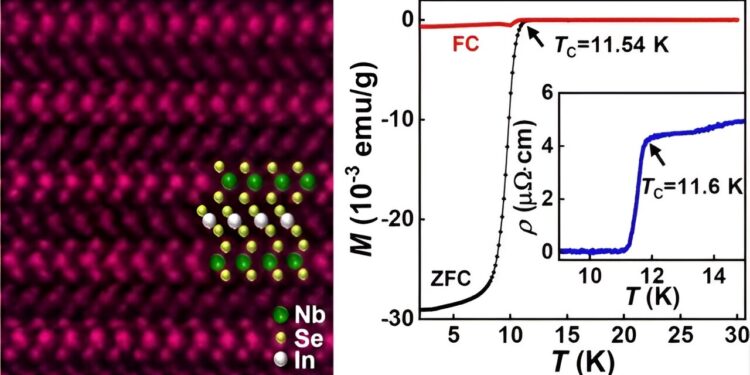by Zhao Weiwei and Zhang Changjin, Hefei Institutes of Physical Sciences, Chinese Academy of Sciences
The crystal structure and superconducting properties of (InSe2)0.12NbSe2. Credit: Niu Rui
With the support of the Stable High Magnetic Field Facility (SHMFF) Electric Transportation and Magnetic Measurement Systems, a research team from Hefei Institutes of Physical Sciences (HFIPS), Chinese Academy of Sciences (CAS) , discovered a new superconducting material called (InSe2)XNbSe2, which has a unique network structure. The superconducting transition temperature of this material reaches 11.6 K, making it the transition metal sulfide superconductor with the highest transition temperature under ambient pressure.
The results were published in Journal of the American Chemical Society.
TMD materials have received much attention due to their numerous applications in catalysis, energy storage, and integrated circuits. However, the relatively low superconducting transition temperatures of TMD superconductors have limited their potential use.
In this study, scientists succeeded in manufacturing a new superconducting material with the chemical formula (InSe2)XNbSe2. Unlike conventional conditions where isolated atoms are inserted into the Van de Waals spaces of low-dimensional materials, in (InSe2)XNbSe2 intercalated indium atoms were found to form InSe2-linked channels.
“This material has a very high transition temperature among all transition metal dichalcogenide (TMD) superconductors,” said Professor Zhang Changjin, who led the team, “and it exhibits an impressive critical current density. “
The superconducting transition temperature of (InSe2)0.12NbSe2 the sample could reach 11.6 K at ambient pressure, which is 60% higher than that of pristine NbSe2.
Furthermore, the (InSe2)XNbSe2 the superconductor has a large critical current density of 8×105 A/cm2, which is also the highest among all TMD superconductors. The critical current density is comparable to that of high-temperature superconductors such as cuprate and iron-based compounds, demonstrating its good application prospects.
This discovery opens new possibilities for advancing superconductivity research and developing high-temperature superconductors with improved performance, according to the team.
More information:
Rui Niu et al, Enhanced superconductivity and critical current density due to the interaction of InSe2 bonded layer in (InSe2)0.12NbSe2, Journal of the American Chemical Society (2024). DOI: 10.1021/jacs.3c09756
Provided by Hefei Institutes of Physical Sciences, Chinese Academy of Sciences
Quote: New superconducting material discovered in transition metal dichalcogenide materials (January 19, 2024) retrieved January 19, 2024 from
This document is subject to copyright. Apart from fair use for private study or research purposes, no part may be reproduced without written permission. The content is provided for information only.



